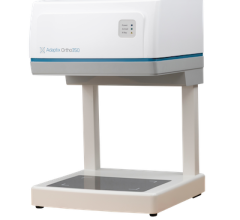
Appearance of same unenhanced CT scan on three reading systems: E-2620 monitor (Barco) (A), Galaxy S8 Plus (Samsung) smartphone (B) and ThinkPad T460s laptop computer (Lenovo) (C).
February 12, 2020 — Mobile devices proved both reliable and accurate for the clinical decision to administer IV thrombolysis in patients with acute stroke, according to an ahead-of-print article in the April issue of the American Journal of Roentgenology (AJR).
To assess reliability and accuracy of IV thrombolysis recommendations made after interpretation of head computed tomography (CT) images of patients with acute stroke symptoms displayed on smartphone or laptop reading systems—compared with those made after interpretation of images displayed on a medical workstation monitor—Antonio J. Salazar at the University of Los Andes in Bogotá, Columbia utilized a factorial design with 188 patients, four radiologists, and three reading systems to produce 2,256 interpretations.
To evaluate reliability, Salazar and colleagues calculated the intraobserver and interobserver agreements using the intraclass correlation coefficient (ICC) and five interpretation variables: hemorrhagic lesions, intraaxial neoplasm, stroke dating (acute, subacute, chronic), hyperdense arteries, and infarct size assessment. Accuracy equivalence tests were also performed for the IV thrombolysis recommendation; for this variable, sensitivity, specificity, and ROC curves were evaluated.
Good or very good intraobserver agreements were observed for all the variables. Specifically, for those variables required to establish contraindications for IV thrombolysis, the agreements were ranked as very good. “This finding is important,” wrote Salazar et al., “because it reflects the good performance of mobile devices to evaluate the most significant imaging variables for clinical decisions.”
For IV thrombolysis recommendation, the main subject of this evaluation, the interobserver agreements for the three reading systems were ranked as very good (ICC > 0.88). Similarly, very good intraobserver agreements were observed for all comparisons (ICC > 0.84). The AUC values (0.83–0.84) and sensitivities (0.94–0.95) for IV thrombolysis recommendation were equivalent among all the reading systems at a 5 percent equivalent threshold.
A unique assessment of imaging-based recommendations for the administration of IV recombinant tissue plasminogen activator based on unenhanced brain CT scans, Salazar also noted: “These results constitute a strong foundation for the development of mobile-based telestroke services because they increase neuroradiologist availability and the possibility of using reperfusion therapies in resource-limited countries.”
For more information: www.arrs.org


 December 01, 2025
December 01, 2025 









